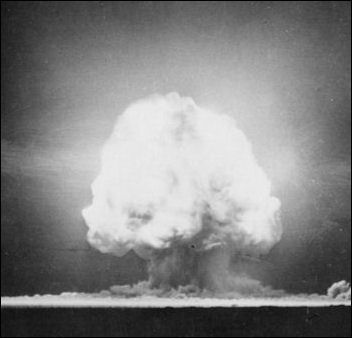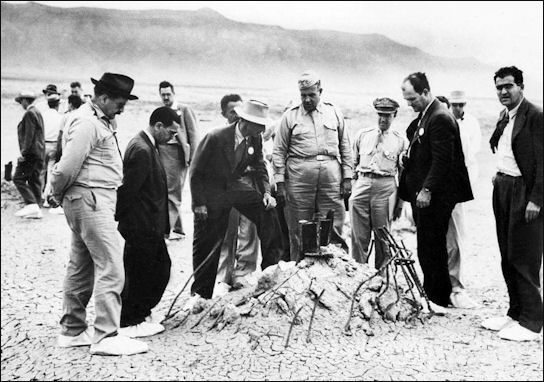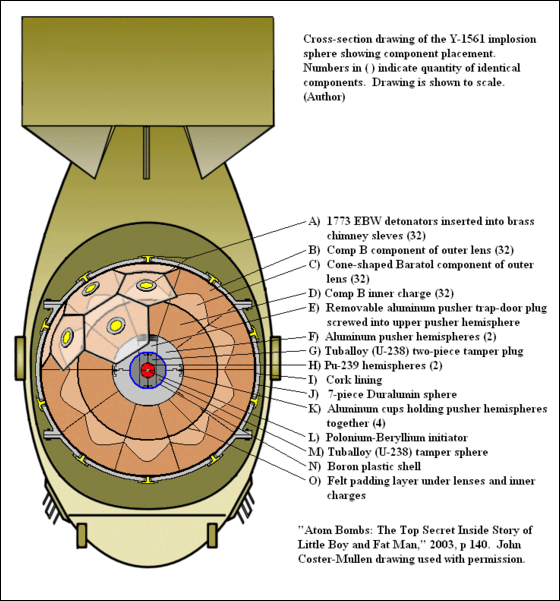FEARS OF NUCLEAR WAR

Robert Oppenheimer, the main man behind the nuclear bomb
Sergei Khrushchev, the premier’s son, wrote, "At the time of Stalin's death in 1953, everything seemed to heading toward a real war, a nuclear war...At the beginning of the 1950s Stalin ordered an accelerated build up not only of the Soviet Union's armed forced but also those of the Warsaw pact allies as well, in order to be fully mobilized and ready for an armed class by 1954 or 1955. By March 1953, the number of Soviet armed personnel had head reached 5,394,038."
The Russians believed that the election of Eisenhower meant that war was imminent. The reasoning was otherwise why did the U.S. need a general to run the country. A popular joke told in the Soviet Union at that time went: "If an atomic bomb explodes, cover yourself with a sheet and crawl to the cemetery, but without hurrying. Why without hurrying? So as not cause panic."
In September 1961, U.S. President John Kennedy urged Americans to build fall out shelters. Schools conducted duck and cover drills.
Nuclear War Strategies
In a report on nuclear warfare, one analyst concluded: “people are easy to kill.” What is more difficult is knocking out military targets. The killing power of a nuclear weapon depends on how large it is but also whether its explodes: in the air or on the ground. The latter produces more radioactive fallout.
On January 12, 1955, the U.S. Secretary of State detailed a new nuclear policy: "massive retaliation." In 1957, Eisenhower gave U.S. military commanders advance permission to use nuclear weapons if they believed there was a serious threat from the Soviet Union and they could not reach him.
The United States had an advantage at this point. It had more advanced technology and air bases and missiles surrounding the Soviet Union. Until the invention of rockets, the Soviet Union didn't have weapons that could retaliate against a U.S. strike.
Stalin realized this and ordered the construction of 10,000 tactical bombers and airfields on Arctic ice for them Stalin's death prevented the plan from being carried out. He did station 100,000 men in tents above the Arctic Circle and told them to be prepared for an American invasion from Alaska.
First Strike Nuclear Strategy

Trinity explosion at Los Alamos
In the mid 1950s the idea of a first strike attack was raised; that a surprise attack could be averted if a first strike was launched first. Some policy makers though that the United States had sufficient superiority to justify such a strategy, U.S. President Dwight Eisenhower rejected the scheme.
The first strike strategy was reconsidered by a team that included Henry Kissinger at the time of the Berlin crises in the early 1960s when John Kennedy was the U.S. President. One general told Kennedy “the time of our greatest danger of a Soviet surprise attack is now and advised that “if a general atomic war is inevitable, the U.S. should strike first.”
A first strike study at that time concluded that the United States could launch 2,258 missiles and bombers with 3,423 nuclear weapons at 1,077 “military and urban-industrial targets” throughout the “Sino-Soviet Bloc,” killing 54 percent of the population of the Soviet Union and destroying 82 percent of its buildings.
A limited attack that avoided major population center s was also considered. The primary targets of such an attack in the 1960s were the 46 home bases for Soviet nuclear bombers, the bomber’s 26 staging bases, eight ICBM sites (with two “aiming points” for each site, or 16 targets in all)—for a total of 88 sites, or in military-speak, DGZs (“designated ground zeros”). The estimated deaths form such an attack would be around 1 million people. The idea of such an attack was to knockout the Soviet Union’s nuclear capabilities keeping deaths low enough (500,000 to 1 million) to convince the Soviet surrender was their only option and discourage an “irrational urge for revenge.”
Mutual Assured Destruction
The nuclear strategy of Russia and the United States has been based on the principles of Mutual Assured Destruction (the idea neither side would launch an attack if they knew they would be annihilated by other side of they did) and the triad system (nuclear weapons delivered by intercontinental ballistic missiles, planes and submarines). The idea behind the triad is that it almost impossible to have a defense against all three weapons-delivery systems.
At the end of the Cold War, the Soviet Union had the capability of striking every U.S. missile silo with two warheads. The Soviets had a plan to hit 100 American cities with three bombs each in the event of a nuclear war.
In January 2000, Russia issued a new security doctrine. It allowed leaders to use all existing forces, "including nuclear weapons" to oppose an enemy attack. Military experts say that because Russia's conventional forces are so weak it has to rely in nuclear weapons to deter an attack. In October 2003, the Russian Defense Minister ruled out the possibility of a preemptive nuclear strike. He did say however “Russia still regards nuclear weapons as a means of political deterrent.”
During the Cold War, the Arctic was regarded as a likely staging area for World War III. The Soviet Union and the United States prepared contingency plans in which submarines would punch holes through Arctic ice to fire ballistic missiles with nuclear warheads at targets in their rival's territory. Things like topography, currents, temperature and salinity in the Arctic Ocean were all carefully studied because they affect acoustics, which in turn affect a submarine's ability to hide from pursuers.

Oppenheimer and Groves at Trinity test site
Nuclear Command
The Russian nuclear command and control system works like this: 1) an early warning system with radar and satellite is used to detect missiles and nuclear weapons aimed at targets in Russia. 2) Military personnel receive warnings on terminal called Krokus. 3) If a warning is authorized it is passd via a system of cables, radio signals and satellites to Kavdaz. 4) The warning triggers alarms in the "football" suitcases in the possession of the Russian president, the minister of defense and chief of the general staff.
The suitcases have terminals that relay information about what is happening. The Russian president, the minister of defense and chief of the general staff confer on the matter. If it seems like a nuclear attack is in progress: 1) The president gives permission of launch warheads; 2) permission travels back to the General Staff, where it is verified; 3) the General staff issues commands for the deployment of weapons; 4) After the orders travel through the Baksan verification system an order is given to launch the nuclear weapons. In some cases the military's general staff is authorized to act on their own. 5) the weapons are launched.
Many analysts, worry that may of the problems that are hurting the Russian military could compromise their nuclear command system. In addition many command posts and radar instillation are no longer on Russian soil but are in former Soviet republics.
The Soviets developed a tunnel system, bunkers and secret subway lines in urban areas and rural areas to protect its leaders in the event of nuclear war.
Nuclear Triad
A nuclear triad refers to the nuclear weapons delivery of a strategic nuclear weapons. It consists of three componentsL 1) traditional strategic bombers, 2) intercontinental ballistic missiles (ICBMs), and 3) submarine-launched ballistic missiles (SLBMs). The purpose of having a three-branched nuclear capability is to significantly reduce the possibility that an enemy could destroy all of a nation's nuclear forces in a first-strike attack; this, in turn, ensures a credible threat of a second strike, and thus increases a nation's nuclear deterrence.
United States triad: 1) Minutemen III missiles, 2) D-5 missiles in Trident I ballistic missiles and 2) bombs dropped or launched from B-2 stealth bombers, B-52 bombers and B-1 bombers. In the event of a nuclear attack B-2 bombers and stealthy advanced cruise missile could probably easily penetrate into Soviet airspace at a low altitude. Missiles launched from submarines would enter Russian airspace so quickly they could probably hit their targets before the Russians could react.
The Russian nuclear triad consists of :1) warheads mounted from land-based missiles like the SS-18 Satan missile; 2) warheads mounted on sub-based missiles carried by 30,000-ton typhoon-class submarines (the world's largest, with 20 missiles with 10 warheads each); 3) warheads released from bombers like the supersonic Tu-160 Blackjack bomber (outfit with nuclear-armed AS-15 cruise missiles).
Submarines with warhead-tipped ballistic missiles are based in Murmansk in the Arctic and Petropavlovsk-Kamchatski in the Far east. Nuclear-capable Fencer and Backfire heavy bombers are in Engals (about halfway between Moscow and the Caspian Sea) and base northwest of Vladivostok.
The primary Russian bombers are the Tu-160 Blackjack bombers and Tu-22M Backfire bombers. The Tu-160 Blackjack bombers were the last and most expensive plane manufactured by the Soviet Union. They were copies of the American B-1 bomber and could travel twice the speed of the sound.

Fat Man internal components
Nuclear Missiles
Land-based warheads are mounted on three kinds of missiles: 1) solo-based Intercontinental Ballistic Missiles (ICBMs); 2) road-mobile ICBMs; and 3) rail mobile ICBMs. These missiles are based in a number of sites across southern Russia.
The SS-18 are the most powerful ICBM (intercontinental ballistic missile). They each have ten 750-kilotons MIRVs (multiple independently targetable re-entry vehicles) warheads. The SS-19 missiles, which are also in operation , have six warheads each. Russia also possesses ship- and submarine-launched cruise missiles. The U.S. answer to the SS-18s were the Peacekeeper ICBMs, each with ten nuclear warheads.
In June 2004, Russia successfully test launched three ballistic missiles: 1) a RSM-54 missile from a submarine; 2) another from the Baikonur cosmodrone in Kazakhstan; and an aircraft-launched cruise missile. In Decameter 2004, Russia test fired an ICBM its calls the RS-20V Voevod and NATO identified as the SS-18 Satan. The missile was fired in the southern Urals. It landed in the Far East. It was the first time Russia had test fired a large ICBM since the beak up of the Soviet Union in 1991.
In November 2004, Putin announced that Russia would soon deploy a nuclear weapons more powerful than anything possessed by the United States or anyone else. Experts think he was talking about new nuclear-equipped Topol missiles, ICBMs, capable of “deep maneuvering” around “Star Wars” missile-defense systems.
Decline of Russia’s Nuclear Arsenal
Russia doesn't have the funds to adequately maintain and upgrade its nuclear weapons systems. Nuclear-powered submarines are mothballed because their isn't enough money to keep them afloat. Of the 62 strategic submarines in 1990 only are 23 are operational and only two are usually at sea and most don't go far. In the 1990s, the largest group of Blackjack bombers was rusting away in the Ukraine. Efforts to negotiate their return to Russia went nowhere. At that time only four the Blackjack bombers in Russia were considered airworthy.
The number of nuclear weapons was shrinking faster than the START I treaty called for because money normally used for maintaining these devices was needed to pay soldiers. Maintenance of the nuclear arsenal costs as much as $3 billion a year, more than 10 percent of Russia’s entire national budget. According to some experts the Russian nuclear arsenal was in such sad shape in the early 2000s that only 600 to 8000 warheads were useable.
The electronics in nuclear missile systems needs to be regularly replaced and carefully maintained. The Russian government reportedly has only about 10 percent of the funds necessary to do that. Bomb shelters built for protection from American warplanes are now used to grow mushrooms.
To make up for the poor state of its conventional forces, the Russian military is pushing the development of low-yield tactical nuclear weapons which can be used on the battlefield instead of tanks and artillery. The Russian army has even conducted military exercises based on using tactical nuclear weapons.

Hiroshima damage map
Nuclear Close Calls
In 1980, a computer chip failed at the Norad command post in Colorado, creating a false alarm for an all-out nuclear attack. The officer in charge, who waited for eight minutes of make a decision, was fired. He was supposed to make the decision in three minutes
In 1987, a German teenager Mathias Rust flew a small plane through Soviet air defenses and landed near Red Square in Moscow. The plane was tracked several times by Soviet air defence and interceptors. Military officials were embarrassed because they failed to do anything about the plane, which conceivably could have bombed the Kremlin.
In February 1995, an American-Norwegian research rocket, whose purpose was to study the aurora borealis, was launched from Norway. It was mistaken for a missile that could be carrying a nuclear weapon. Russian President Boris Yeltsin was notified and given the commands to launch a nuclear war via his suitcase. On Yeltsin's briefcase a light turned on and after he opened it could he see a an electronic map with a bright dot over the Norwegian Sea. Below the map was an option of attacks on United States targets. After a tense 12 minutes Russian military observers could see the missile was not headed for Russia. It was the first time a Russian leader used his brief case in a real alert situation.
The Norwegian Foreign Ministry had sent a letter to Russia and other neighboring countries about the rocket launch but the letter never made its way through the Russian bureaucracy to people who monitored the command posts for incoming missiles. Norway had launched 607 scientific rockets since 1962 but the one that caused the scare had four stages and was much larger than ones launched in the past. Analysts believe it may have looked on a Russian radar screen like a missile launched from a U.S. Trident submarine.
In an effort to keep things like the false alarm over the Norwegian rocket from happening again, the United States and Russia promised to build a joint nuclear early warning center. As of June 2001, all there was to show for the effort on the Russian side was the selection of a dilapidated and abandoned kindergarten building on the outskirts of Moscow for the center.
As of July 2001, only two to five of the nine high-elliptical satellites that Russia had orbited since 1995 were still in orbit. This meant that Russia was blind to a possible launch of U.S. missiles seven hours a day.
Image Sources:
Text Sources: New York Times, Washington Post, Los Angeles Times, Times of London, Lonely Planet Guides, Library of Congress, U.S. government, Compton’s Encyclopedia, The Guardian, National Geographic, Smithsonian magazine, The New Yorker, Time, Newsweek, Reuters, AP, AFP, Wall Street Journal, The Atlantic Monthly, The Economist, Foreign Policy, Wikipedia, BBC, CNN, and various books, websites and other publications.
Last updated May 2016
